Oral supplementation with liposomal glutathione elevates body stores of glutathione and markers of immune function
Glutathione (GSH) is the most abundant endogenous antioxidant and a critical regulator of oxidative stress. Maintenance of optimal tissues for GSH levels may be an important strategy for the prevention of oxidative stress-related diseases. We investigated if oral administration of liposomal GSH is effective at enhancing GSH levels in vivo.
Subjects/Methods:
A 1-month pilot clinical study of oral liposomal GSH administration at two doses (500 and 1000 mg of GSH per day) was conducted in healthy adults. GSH levels in whole blood, erythrocytes, plasma and peripheral blood mononuclear cells (PBMCs) were assessed in 12 subjects at the baseline and after 1, 2 and 4 weeks of GSH administration.
Results:
Conclusions:
Collectively, these preliminary findings support the effectiveness of daily liposomal GSH administration at elevating stores of GSH and impacting the immune function and levels of oxidative stress.
This is a preview of subscription content, access via your institution
Access options
Subscribe to this journal
Receive 12 print issues and online access
265,23 € per year
only 22,10 € per issue
Buy this article
- Purchase on SpringerLink
- Instant access to full article PDF
Prices may be subject to local taxes which are calculated during checkout
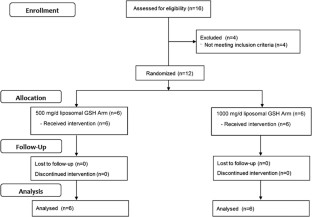
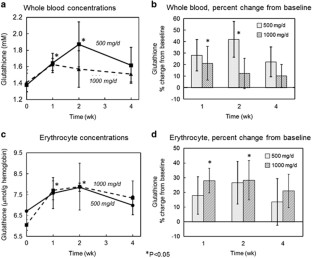
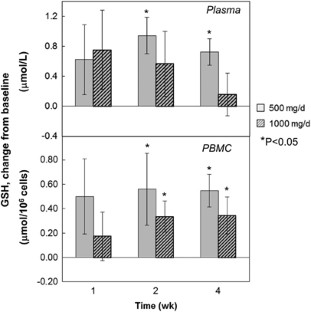
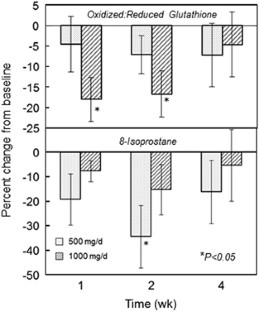

Similar content being viewed by others
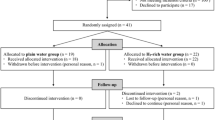
Hydrogen-rich water reduces inflammatory responses and prevents apoptosis of peripheral blood cells in healthy adults: a randomized, double-blind, controlled trial
Article Open access 22 July 2020
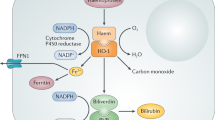
Regulation of inflammation by the antioxidant haem oxygenase 1
Article 29 January 2021
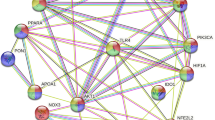
Redox regulation of the immune response
Article Open access 02 September 2022
References
- Lu SC . Regulation of hepatic glutathione synthesis: current concepts and controversies. FASEB J 1999; 13: 1169–1183. ArticleCASGoogle Scholar
- Meister A, Anderson ME . Glutathione. Annu Rev Biochem 1983; 52: 711–760. ArticleCASGoogle Scholar
- Vina J . Glutathione: Metabolism and Physiological Functions. CRC Press: Boca Raton, 1990. Google Scholar
- Giustarini D, Rossi R, Milzani A, Colombo R, Dalle-Donne I . S-glutathionylation: from redox regulation of protein functions to human diseases. J Cell Mol Med 2004; 8: 201–212. ArticleCASGoogle Scholar
- Forman HJ, Zhang H, Rinna A . Glutathione: overview of its protective roles, measurement, and biosynthesis. Mol Aspects Med 2009; 30: 1–12. ArticleCASGoogle Scholar
- Droge W, Breitkreutz R . Glutathione and immune function. Proc Nutr Soc 2000; 59: 595–600. ArticleCASGoogle Scholar
- Hamilos DL, Zelarney P, Mascali JJ . Lymphocyte proliferation in glutathione-depleted lymphocytes: direct relationship between glutathione availability and the proliferative response. Immunopharmacology 1989; 18: 223–235. ArticleCASGoogle Scholar
- Griffith OW . Biologic and pharmacologic regulation of mammalian glutathione synthesis. Free Radic Biol Med 1999; 27: 922–935. ArticleCASGoogle Scholar
- Zhang H, Forman HJ . Glutathione synthesis and its role in redox signaling. Semin Cell Dev Biol 2012; 23: 722–728. ArticleCASGoogle Scholar
- Vogt BL, Richie JP Jr. . Fasting-induced depletion of glutathione in the aging mouse. Biochem Pharmacol 1993; 46: 257–263. ArticleCASGoogle Scholar
- Jaeschke H, Wendel A . Diurnal fluctuation and pharmacological alteration of mouse organ glutathione content. Biochem Pharmacol 1985; 34: 1029–1033. ArticleCASGoogle Scholar
- Jollow DJ . Glutathione thresholds in reactive metabolite toxicity. Arch Toxicol Suppl 1980; 3: 95–110. ArticleCASGoogle Scholar
- Ellouk-Achard S, Levresse V, Martin C, Pham-Huy C, Dutertre-Catella H, Thevenin M et al. Ex vivo and in vitro models in acetaminophen hepatotoxicity studies. Relationship between glutathione depletion, oxidative stress and disturbances in calcium homeostasis and energy metabolism. Arch Toxicol Suppl 1995; 17: 209–214. ArticleCASGoogle Scholar
- Townsend DM, Tew KD, Tapiero H . The importance of glutathione in human disease. Biomed Pharmacother 2003; 57: 145–155. ArticleCASGoogle Scholar
- Nuttall SL, Martin U, Sinclair AJ, Kendall MJ . Glutathione: in sickness and in health. Lancet 1998; 351: 645–646. ArticleCASGoogle Scholar
- Julius M, Lang CA, Gleiberman L, Harburg E, DiFranceisco W, Schork A . Glutathione and morbidity in a community-based sample of elderly. J Clin Epidemiol 1994; 47: 1021–1026. ArticleCASGoogle Scholar
- Flagg EW, Coates RJ, Eley JW, Jones DP, Gunter EW, Byers TE et al. Dietary glutathione intake in humans and the relationship between intake and plasma total glutathione level. Nutr Cancer 1994; 21: 33–46. ArticleCASGoogle Scholar
- Flagg EW, Coates RJ, Jones DP, Byers TE, Greenberg RS, Gridley G et al. Dietary glutathione intake and the risk of oral and pharyngeal cancer. Am J Epidemiol 1994; 139: 453–465. ArticleCASGoogle Scholar
- Favilli F, Marraccini P, Iantomasi T, Vincenzini MT . Effect of orally administered glutathione on glutathione levels in some organs of rats: role of specific transporters. Br J Nutr 1997; 78: 293–300. ArticleCASGoogle Scholar
- Kariya C, Leitner H, Min E, van Heeckeren C, van Heeckeren A, Day BJ . A role for CFTR in the elevation of glutathione levels in the lung by oral glutathione administration. Am J Physiol Lung Cell Mol Physiol 2007; 292: L1590–L1597. ArticleCASGoogle Scholar
- Aw TY, Wierzbicka G, Jones DP . Oral glutathione increases tissue glutathione in vivo. Chem Biol Interact 1991; 80: 89–97. ArticleCASGoogle Scholar
- Hagen TM, Wierzbicka GT, Sillau AH, Bowman BB, Jones DP . Bioavailability of dietary glutathione: effect on plasma concentration. Am J Physiol 1990; 259: G524–G529. CASPubMedGoogle Scholar
- Vina J, Perez C, Furukawa T, Palacin M, Vina JR . Effect of oral glutathione on hepatic glutathione levels in rats and mice. Br J Nutr 1989; 62: 683–691. ArticleCASGoogle Scholar
- Hunjan MK, Evered DF . Absorption of glutathione from the gastro-intestinal tract. Biochim Biophys Acta 1985; 815: 184–188. ArticleCASGoogle Scholar
- Furukawa T, Meydani SN, Blumberg JB . Reversal of age-associated decline in immune responsiveness by dietary glutathione supplementation in mice. Mech Ageing Dev 1987; 38: 107–117. ArticleCASGoogle Scholar
- Cai J, Chen Y, Seth S, Furukawa S, Compans RW, Jones DP . Inhibition of influenza infection by glutathione. Free Radic Biol Med 2003; 34: 928–936. ArticleCASGoogle Scholar
- Novi AM . Regression of aflatoxin B1-induced hepatocellular carcinomas by reduced glutathione. Science 1981; 212: 541–542. ArticleCASGoogle Scholar
- Trickler D, Shklar G, Schwartz J . Inhibition of oral carcinogenesis by glutathione. Nutr Cancer 1993; 20: 139–144. ArticleCASGoogle Scholar
- Schwartz JL, Shklar G . Glutathione inhibits experimental oral carcinogenesis, p53 expression, and angiogenesis. Nutr Cancer 1996; 26: 229–236. ArticleCASGoogle Scholar
- Shklar G, Schwartz J, Trickler D, Cheverie SR . The effectiveness of a mixture of beta-carotene, alpha-tocopherol, glutathione, and ascorbic acid for cancer prevention. Nutr Cancer 1993; 20: 145–151. ArticleCASGoogle Scholar
- Richie JP Jr, Nichenametla S, Neidig W, Calcagnotto A, Haley JS, Schell TD et al. Randomized controlled trial of oral glutathione supplementation on body stores of glutathione. Eur J Nutr 2015; 54: 251–263. ArticleCASGoogle Scholar
- Kleinman WA, Richie JP Jr . Status of glutathione and other thiols and disulfides in human plasma. Biochem Pharmacol 2000; 60: 19–29. ArticleCASGoogle Scholar
- Rahman I, Kode A, Biswas SK . Assay for quantitative determination of glutathione and glutathione disulfide levels using enzymatic recycling method. Nat Protoc 2006; 1: 3159–3165. ArticleCASGoogle Scholar
- Muscat JE, Kleinman W, Colosimo S, Muir A, Lazarus P, Park J et al. Enhanced protein glutathiolation and oxidative stress in cigarette smokers. Free Radic Biol Med 2004; 36: 464–470. ArticleCASGoogle Scholar
- Drabkin DL . The standardization of hemoglobin measurements. Am J Med Sci 1949; 217: 711–714. Google Scholar
- Schell TD, Mylin LM, Georgoff I, Teresky AK, Levine AJ, Tevethia SS . Cytotoxic T-lymphocyte epitope immunodominance in the control of choroid plexus tumors in simian virus 40 large T antigen transgenic mice. J Virol 1999; 73: 5981–5993. CASPubMedPubMed CentralGoogle Scholar
- Hamilos DL, Wedner HJ . The role of glutathione in lymphocyte activation. I. Comparison of inhibitory effects of buthionine sulfoximine and 2-cyclohexene-1-one by nuclear size transformation. J Immunol 1985; 135: 2740–2747. CASPubMedGoogle Scholar
- Gmunder H, Droge W . Differential effects of glutathione depletion on T cell subsets. Cell Immunol 1991; 138: 229–237. ArticleCASGoogle Scholar
- Morris D, Khurasany M, Nguyen T, Kim J, Guilford F, Mehta R et al. Glutathione and infection. Biochim Biophys Acta 2013; 1830: 3329–3349. ArticleCASGoogle Scholar
- Galter D, Mihm S, Droge W . Distinct effects of glutathione disulphide on the nuclear transcription factor kappa B and the activator protein-1. Eur J Biochem 1994; 221: 639–648. ArticleCASGoogle Scholar
- Suthanthiran M, Anderson ME, Sharma VK, Meister A . Glutathione regulates activation-dependent DNA synthesis in highly purified normal human T lymphocytes stimulated via the CD2 and CD3 antigens. Proc Natl Acad Sci USA 1990; 87: 3343–3347. ArticleCASGoogle Scholar
- Hargrove ME, Wang J, Ting CC . Regulation by glutathione of the activation and differentiation of IL-4-dependent activated killer cells. Cell Immunol 1993; 149: 433–443. ArticleCASGoogle Scholar
- Liang CM, Lee N, Cattell D, Liang SM . Glutathione regulates interleukin-2 activity on cytotoxic T-cells. J Biol Chem 1989; 264: 13519–13523. CASPubMedGoogle Scholar
- Vojdani A, Mumper E, Granpeesheh D, Mielke L, Traver D, Bock K et al. Low natural killer cell cytotoxic activity in autism: the role of glutathione, IL-2 and IL-15. J Neuroimmunol 2008; 205: 148–154. ArticleCASGoogle Scholar
- Huang HY, Helzlsouer KJ, Appel LJ . The effects of vitamin C and vitamin E on oxidative DNA damage: results from a randomized controlled trial. Cancer Epidemiol Biomark Prev 2000; 9: 647–652. CASGoogle Scholar
- Jacob RA, Aiello GM, Stephensen CB, Blumberg JB, Milbury PE, Wallock LM et al. Moderate antioxidant supplementation has no effect on biomarkers of oxidant damage in healthy men with low fruit and vegetable intakes. J Nutr 2003; 133: 740–743. ArticleCASGoogle Scholar
- Ottestad I, Vogt G, Retterstol K, Myhrstad MC, Haugen JE, Nilsson A et al. Oxidised fish oil does not influence established markers of oxidative stress in healthy human subjects: a randomised controlled trial. Br J Nutr 2012; 108: 315–326. ArticleCASGoogle Scholar
- Stewart RJ, Askew EW, McDonald CM, Metos J, Jackson WD, Balon TW et al. Antioxidant status of young children: response to an antioxidant supplement. J Am Diet Assoc 2002; 102: 1652–1657. ArticleCASGoogle Scholar
- Patrignani P, Panara MR, Tacconelli S, Seta F, Bucciarelli T, Ciabattoni G et al. Effects of vitamin E supplementation on F(2)-isoprostane and thromboxane biosynthesis in healthy cigarette smokers. Circulation 2000; 102: 539–545. ArticleCASGoogle Scholar
- Nemzer BV, Rodriguez LC, Hammond L, Disilvestro R, Hunter JM, Pietrzkowski Z . Acute reduction of serum 8-iso-PGF2-alpha and advanced oxidation protein products in vivo by a polyphenol-rich beverage; a pilot clinical study with phytochemical and in vitro antioxidant characterization. Nutr J 2011; 10: 67. ArticleCASGoogle Scholar
- Trebble TM, Wootton SA, Miles EA, Mullee M, Arden NK, Ballinger AB et al. Prostaglandin E2 production and T cell function after fish-oil supplementation: response to antioxidant cosupplementation. Am J Clin Nutr 2003; 78: 376–382. ArticleCASGoogle Scholar
Acknowledgements
We acknowledge the support of the staff of the Pennsylvania State University College of Medicine Clinical Research Center and Investigational Pharmacy. This work was supported by Research Nutritionals, LLC. Liposomal glutathione preparations (Tri-Fortify Orange) were provided by Researched Nutritionals, LLC (Los Olivos, CA, USA). Immunological analyses were supported in part by the Penn State Cancer Institute through the Clinical Correlative Immunology Laboratory (TDS, JPH). The project described was supported in part by the National Center for Advancing Translational Sciences, National Institutes of Health, through Grant 1UL1TR002014-01. The content is solely the responsibility of the authors and does not necessarily represent the official views of the NIH.
Author information
Authors and Affiliations
- Department of Biochemistry and Molecular Biology, Penn State University College of Medicine, Hershey, PA, USA R Sinha & I Sinha
- Department of Public Health Sciences, Penn State University College of Medicine, Hershey, PA, USA A Calcagnotto, N Trushin & J P Richie Jr
- Department of Microbiology and Immunology, Penn State University College of Medicine, Hershey, PA, USA J S Haley & T D Schell
- R Sinha









